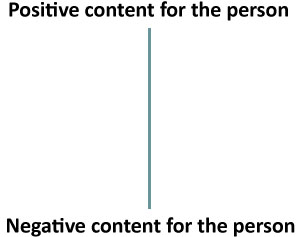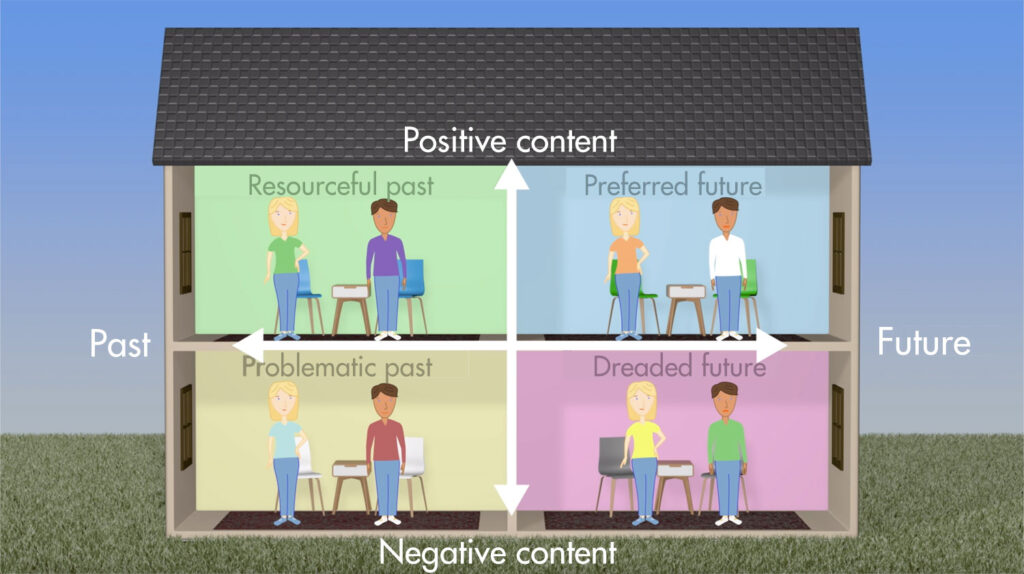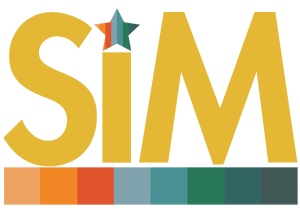Solution-focus background and link to SIM
The solution-focused approach and techniques are salutogeneous, cooperation-oriented and are based on the dialogue during the session.
Steve de Shazer and Insoo Kim Berg, founder of Solution-Focused Brief Therapy, discovered that clients achieved their goals more quickly when they talked more about their strengths and hopes for the future rather than describing their problems at the current time and in the past [1-3]. They also discovered that ‘solution’ behaviour and competence were strengthened through confirmations and complements; clients started to do more of what was working and repressed ‘problem’ patterns in their lives.
As clients perceived more ‘solution’ patterns, so healthy functions returned. De Shazer and Berg concluded that ‘problem’ thoughts and ‘problem’ behaviours had very little link to solutions and ‘solution’ behaviours. They pointed out that change is continually happening in people’s lives and that it is important to find what is useful in order to move towards a desired and better future.
What started as therapy has developed into a coaching working method, which has spread into many sectors and arenas, including education. From the early 1990s and onwards, several successful solution-focused school inventions have been described, linked to, among other things, classroom teaching, social work, counselling and also to reduce student absence [4, 5]. Many of these interventions are based on Insoo Kim Berg’s method development of the feedback-based WOWW Programme. This involves teachers and students becoming trained to notice and work on what is working – “working on what works” [6].
So far, no examples of group-based coaching aimed in particular at promoting mental health have been described involving young people at upper secondary schools. The SIM method, including associated mentor training and methodological support, is a method development of this.
References
- De Shazer, S. (1985). Keys to solution in brief therapy. W. W. Norton & Company.
- De Shazer, S. (1988). Clues: Investigating solutions in brief therapy. W. W. Norton & Company
- De Shazer, S., & Berg, I. K. (1997). ‘What works? Remarks on research aspects of solution-focused. brief therapy.
- Kim, J. S., & Franklin, C. (2009). Solution-Focused brief therapy in schools: A review of the literature. Children and Youth Services Review, 31, 464–470.
- Franklin, C., Biever, J., Moore, K., Clemons, D., & Scamardo, M. (2001). The effectiveness of Solution-Focused therapy with children in a school setting. Research on Social Work Practice, 11, 411–434.
- Brown, E. L., Powell, E., & Clark, A. (2012). Working on what works: Working with teachers to improve classroom behavior and relationships. Educational Psychology in Practice, 28, 19–30.
Comparing solution building and problem solving
“Coaching in a solution-focused way is a special way of listening and talking. As a coach you choose what to focus on, what to confirm and what questions to ask.”
Keeping on a solution-focused track as a group coach involves constantly reminding yourself to reflect, confirm and ask questions relating to what may be clues to future solutions, not trying to understand and discuss reasons for problems and difficult situations. On the other hand, as solution-focused group coaches, we are fully aware that a problem exists. Students may find things difficult, which we must of course confirm. This confirmation is supportive. If you are a solution-building group coach, you ask questions about what is important to the students, about resources and what the students think may be helpful when navigating through their lives. This is solution building.
Dialogic Orientation Quadrant for Solution-Focused dialogues
We also use the Dialogic Orientation Quadrant (DOQ) pedagogical instrument in SIM to illustrate how different dialogues could develop and how therapy leaders can help steer conversations towards resources and the desired situation.
The Dialogic Orientation Quadrant (from Haesun Moon, the Canadian Centre for Brief Coaching) is a helpful model that helps us as group coaches to raise awareness of what we are reinforcing. It is based on a timeline that runs from the past to the future. We can imagine that a discussion is underway just here and now in the middle of the line. A discussion usually involves things that have happened previously and things that may happen in the future.

When we have a coaching discussion, we focus heavily on investigating what the person being coached wants to have more of in their life. The vertical line revolves around content, what is in the person’s life:

At the top of the vertical line, we talk about what the person wants to keep in their life, things that should continue as they are or should be developed or increased. This may involve relationships with others, times when the person is feeling good, good thoughts and good feelings. However, at the bottom of the line, this involves what the person does not want to have in their life.

(reference Haesun Moon – Institute of Coaching).
When you are a group coach for SIM, it is helpful to think of the quadrant in the form of a house, with two rooms for discussions on the upper floor and two rooms for discussions on the ground floor. You can develop your coaching using the rooms in the house as a metaphor.
It is not wrong to be in any of the rooms. When people have problems and are on the ground floor, we need to listen and confirm this and should also ask questions about what the student can do to deal with difficult situations. Solution-focused coaching then involves finding ways of taking the dialogue up to the upper floor and building solutions using resources and the desire to progress towards what the student wants for their future.

